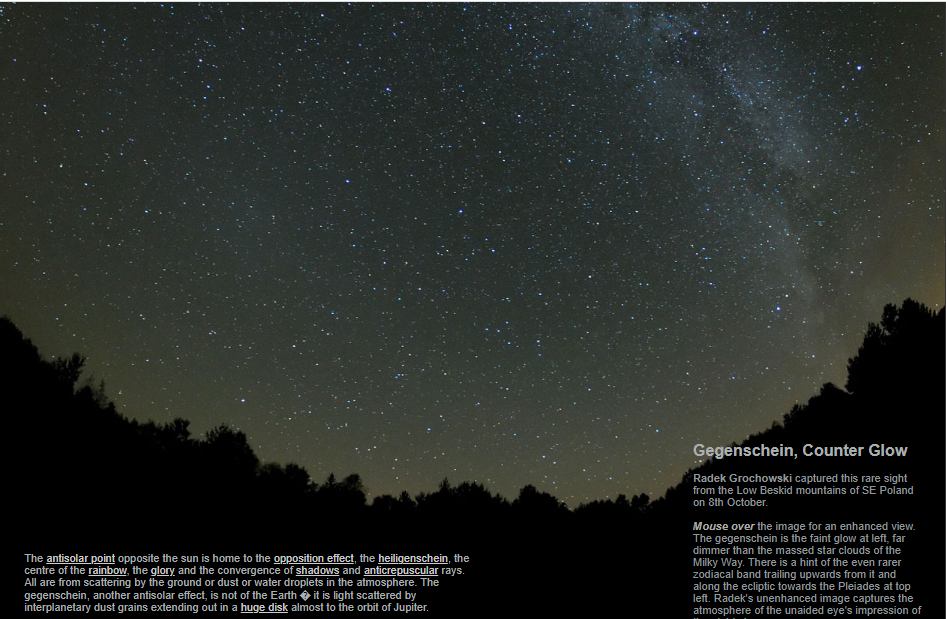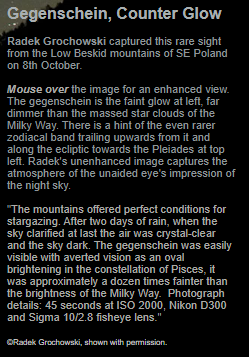OPOD - Gegenschein, Counterglow
OPOD - Gegenschein, Counterglow: Exploring a Rare Atmospheric Phenomenon
Have you ever gazed up at the night sky and noticed a faint glow in the opposite direction of the sun? This captivating sight is known as the gegenschein, or counterglow. While not as prominent as the dazzling star clouds of the Milky Way, the gegenschein holds its own allure. In this article, we will delve into the world of atmospheric optics to understand this rare phenomenon in greater detail.
The gegenschein was recently captured by astrophotographer Radek Grochowski from the Low Beskid mountains of SE Poland. His image provides a glimpse into the atmosphere's impression of the night sky, allowing us to appreciate the beauty of this ethereal glow. With its oval shape and location within the constellation of Pisces, the gegenschein appears approximately twelve times fainter than the Milky Way.
To fully comprehend the nature of the gegenschein, we must explore its origins. Unlike other atmospheric phenomena that arise from Earth's elements, such as dust or water droplets, the gegenschein is not of terrestrial origin. Instead, it is a result of light scattering by interplanetary dust grains that extend in a vast disk nearly reaching the orbit of Jupiter.
Each interplanetary dust grain is between 1 and 300 microns in size, residing miles apart from its nearest neighbor. These grains are relatively large in terms of visible light and predominantly scatter sunlight forwards, albeit with a slight deflection. However, some of the scattered light is directed backwards, albeit less strongly. It is this backward scattering that gives rise to the mesmerizing gegenschein.
While many are familiar with the zodiacal light, which is visible before sunrise and after sunset due to sunlight forward scattered by particles between Earth and Mercury's orbit, the gegenschein remains more elusive. The zodiacal light is often described as visible only in or near the tropics, where the ecliptic makes a steep angle with the horizon. However, under the right conditions of unpolluted skies and the appropriate time of year, the zodiacal light can be observed in Northern Europe, Canada, and the USA.
In contrast, the gegenschein is significantly fainter and more challenging to observe. Radek Grochowski's image from Poland is a remarkable achievement, possibly being the first documented gegenschein sighting from such a northern location. This serves as a testament to the crystal-clear skies and perfect stargazing conditions that presented themselves after two days of rain.
To capture the gegenschein on camera, Radek employed a Nikon D300 and a Sigma 10/2.8 fisheye lens. With an exposure time of 45 seconds and an ISO setting of 2000, he successfully immortalized this celestial phenomenon. His photograph not only showcases the beauty of the gegenschein but also highlights its significance as an atmospheric optics marvel.
In conclusion, the gegenschein, or counterglow, is a captivating atmospheric phenomenon that occurs when sunlight scatters backward by interplanetary dust grains. Its faint glow, although much dimmer than the Milky Way, holds a unique allure for stargazers and astrophotographers alike. While challenging to observe, particularly from northern locations, Radek Grochowski's image from Poland showcases the rarity and beauty of this celestial spectacle. So next time you find yourself under a dark and unpolluted sky, take a moment to look towards the antisolar point and see if you can catch a glimpse of the elusive gegenschein.


Gegenschein, Counter Glow
Radek Grochowski captured this rare sight from the Low Beskid mountains of SE Poland on 8th October.
Mouse over the image for an enhanced view. The gegenschein is the faint glow at left, far dimmer than the massed star clouds of the Milky Way. There is a hint of the even rarer zodiacal band trailing upwards from it and along the ecliptic towards the Pleiades at top
left. Radek's unenhanced image captures the atmosphere of the unaided eye's impression of the night sky.
"The mountains offered perfect conditions for stargazing. After two days of rain, when the
sky clarified at last the air was crystal-clear and the sky dark. The gegenschein was easily
visible with averted vision as an oval brightening in the constellation of Pisces, it was approximately a dozen times fainter than the brightness of the Milky Way. Photograph details: 45 seconds at ISO 2000, Nikon D300 and Sigma 10/2.8 fisheye lens."
©Radek Grochowski, shown with permission.

The antisolar point opposite the sun is home to the opposition effect, the heiligenschein, the centre of the rainbow, the glory and the convergence of shadows and anticrepuscular rays. All are from scattering by the ground or dust or water droplets in the atmosphere. The gegenschein, another antisolar effect, is not of the Earth � it is light scattered by interplanetary dust grains extending out in a huge disk almost to the orbit of Jupiter.
Each grain is 1- 300 micron (0.001 - 0.3 mm) across miles from a neighbour. By the standards of visible light it is large and mostly scatters sunlight forwards, only slightly deflected, but some is scattered backwards though less strongly.
Sunlight forward scattered by particles between Earth and Mercury's orbit give us the pearly cone seen before sunrise and after sunset, the zodiacal light. The gegenschein is backwards scattered light by particles outwards from Earth to the asteroid belt.
The brighter zodiacal light is elusive enough. It used to be described as visible only in or near the tropics where the ecliptic makes a steep angle with the horizon. However, at the right time of year and with skies unpolluted by artificial lights it can be seen in Northern Europe, Canada and USA. The much fainter gegenschein is much harder and Radek�s image from Poland is possibly a first from so far north.
Note: this article has been automatically converted from the old site and may not appear as intended. You can find the original article here.
Reference Atmospheric Optics
If you use any of the definitions, information, or data presented on Atmospheric Optics, please copy the link or reference below to properly credit us as the reference source. Thank you!
-
<a href="https://atoptics.co.uk/blog/opod-gegenschein-counterglow/">OPOD - Gegenschein, Counterglow</a>
-
"OPOD - Gegenschein, Counterglow". Atmospheric Optics. Accessed on December 27, 2024. https://atoptics.co.uk/blog/opod-gegenschein-counterglow/.
-
"OPOD - Gegenschein, Counterglow". Atmospheric Optics, https://atoptics.co.uk/blog/opod-gegenschein-counterglow/. Accessed 27 December, 2024
-
OPOD - Gegenschein, Counterglow. Atmospheric Optics. Retrieved from https://atoptics.co.uk/blog/opod-gegenschein-counterglow/.